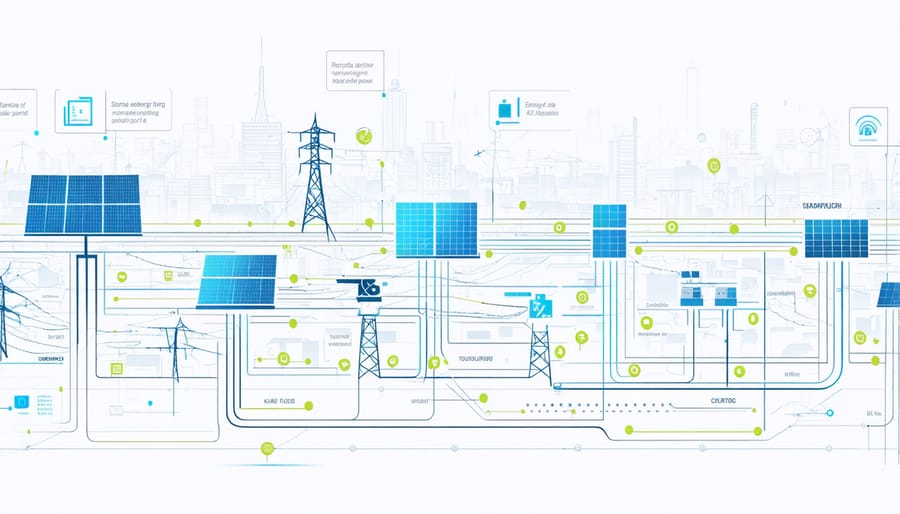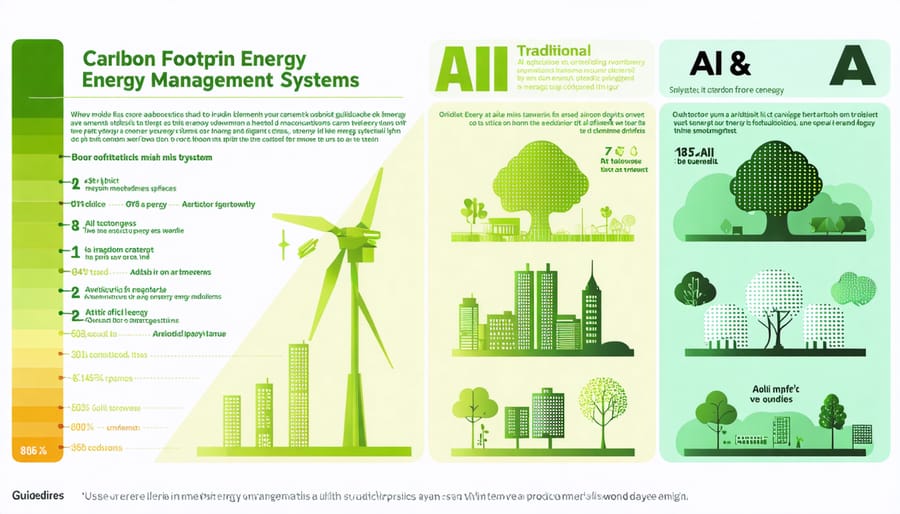AI Energy Management: Hidden Environmental Costs You Should Know

The environmental impact of artificial intelligence presents a complex paradox in our fight against climate change. While smart energy storage solutions and AI-driven efficiency improvements help reduce emissions, the technology’s growing energy appetite raises serious environmental concerns. Data centers powering AI systems now consume more electricity annually than many small European nations combined, with their carbon footprint expected to triple by 2030.
Yet this narrative only tells part of the story. AI’s potential to optimize power grids, reduce waste, and accelerate renewable energy adoption could offset its environmental costs several times over. From predictive maintenance in wind farms to intelligent building management systems, AI applications are already delivering measurable environmental benefits across Europe’s energy landscape.
The critical question isn’t whether AI is categorically good or bad for the environment, but rather how we can harness its capabilities while minimizing its ecological footprint. As European businesses and households increasingly rely on AI-powered solutions, understanding this balance becomes essential for making informed decisions about our technological future.
The Energy Paradox of AI Systems
Computing Power Requirements
The computational demands of artificial intelligence systems pose significant environmental challenges. Modern AI models, particularly large language models and deep learning systems, require extensive server infrastructure and consume substantial amounts of electricity. For instance, training a single advanced AI model can consume as much energy as five cars throughout their entire lifetime.
Data centres housing AI operations typically run 24/7 and require constant cooling to maintain optimal performance. In Europe alone, data centres account for approximately 2.7% of electricity demand, with AI applications comprising an increasingly significant portion of this consumption. The carbon footprint extends beyond direct energy usage, as the manufacturing and replacement of hardware components also contribute to environmental impact.
However, innovations in energy-efficient computing and sustainable data centre design are helping to mitigate these effects. European initiatives are leading the way in developing green computing solutions, including the use of renewable energy sources and advanced cooling systems that reduce overall energy consumption. Some facilities now implement heat recovery systems, channelling excess server heat into district heating networks.
The key to sustainable AI development lies in balancing computational power with environmental responsibility. Companies are increasingly adopting energy-efficient algorithms and optimising their AI models to require less processing power while maintaining effectiveness.
Data Center Impact
The rapid growth of artificial intelligence has led to a significant expansion of data centres across Europe and globally. These facilities, which power AI operations, consume substantial amounts of electricity and require extensive cooling systems to maintain optimal performance. Current estimates suggest that training a single large AI model can generate as much carbon dioxide as five cars over their entire lifetime.
European data centres currently account for approximately 2.7% of the continent’s electricity consumption, with AI applications driving this figure higher each year. The environmental impact extends beyond energy usage – these facilities require vast amounts of water for cooling systems and contribute to electronic waste through regular hardware upgrades.
However, innovative solutions are emerging to address these challenges. Many European data centres are transitioning to renewable energy sources, implementing advanced cooling technologies, and optimising their operations through AI-powered efficiency measures. Companies like Google and Microsoft have committed to carbon-neutral data centre operations, while smaller providers are following suit with sustainable practices.
The key to minimising environmental impact lies in balancing AI advancement with sustainable infrastructure. This includes selecting energy-efficient hardware, implementing heat recycling systems, and prioritising locations with access to renewable energy sources. As the industry evolves, the focus increasingly shifts toward developing more environmentally conscious AI solutions that require less computational power while maintaining effectiveness.

Environmental Benefits of AI in Energy Storage
Grid Optimization
Artificial Intelligence is revolutionizing energy grid management, offering significant environmental benefits through enhanced distribution efficiency. By analyzing vast amounts of real-time data from smart meters, weather patterns, and consumption trends, AI algorithms optimize power flow across networks, reducing waste and minimizing carbon emissions.
These intelligent systems work in tandem with grid-scale battery systems to balance supply and demand more effectively. When renewable energy sources like wind and solar produce excess power, AI determines the optimal storage strategy, ensuring this clean energy isn’t wasted. During peak demand periods, the system intelligently releases stored energy, reducing reliance on fossil fuel-based power plants.
In European markets, AI-powered grid optimization has shown remarkable results. For instance, Germany’s implementation of AI grid management has helped integrate its growing renewable energy capacity, reducing grid stabilization costs by up to 30%. The technology predicts maintenance needs before equipment failures occur, preventing energy waste from system inefficiencies.
Moreover, AI enables dynamic load balancing, automatically redirecting power to areas with highest demand while maintaining grid stability. This smart distribution reduces transmission losses and extends the life of infrastructure components, creating a more sustainable energy ecosystem. For homeowners and businesses, this translates to more reliable power supply and lower energy costs, while significantly reducing the environmental impact of power distribution.

Renewable Integration
Artificial Intelligence is proving to be a powerful ally in maximizing renewable energy integration across European power grids. Smart AI systems are revolutionizing how we harness and distribute clean energy by precisely predicting weather patterns, optimizing energy storage, and balancing supply with demand in real-time.
These AI-powered solutions enable grid operators to integrate higher percentages of variable renewable sources like wind and solar while maintaining grid stability. For instance, in Germany, AI algorithms have helped increase renewable energy utilization by up to 30% through improved forecasting and dynamic load management.
The technology’s impact extends beyond grid management to individual installations. AI systems help homeowners and businesses optimize their solar panel performance by adjusting angles, predicting maintenance needs, and managing energy storage systems more efficiently. This smart integration means less waste and more effective use of renewable resources.
Moreover, AI-driven microgrids are emerging across Europe, creating localized energy networks that can operate independently or in conjunction with the main grid. These systems use machine learning to balance local generation and consumption, reducing transmission losses and increasing overall system efficiency.
While the computing power required for these AI systems does consume energy, the net environmental benefit is significantly positive. Studies indicate that AI-enabled renewable integration could reduce carbon emissions by up to 10% in the power sector alone, marking a crucial step toward Europe’s sustainability goals.
Waste Reduction
Artificial Intelligence plays a crucial role in minimizing environmental impact through sophisticated waste reduction strategies. By implementing advanced battery management systems, AI algorithms optimize energy storage and distribution, reducing unnecessary power consumption and extending battery life cycles.
These smart systems continuously analyze usage patterns and adjust power allocation in real-time, preventing energy waste through predictive maintenance and intelligent load balancing. In data centers, AI-powered cooling systems can reduce energy consumption by up to 40% by precisely controlling temperature and airflow based on actual server usage rather than maintaining constant cooling.
AI also enhances storage efficiency by optimizing data compression and management. Through machine learning algorithms, systems can identify and eliminate redundant data, reducing storage requirements and the associated energy consumption. This improvement in data storage efficiency directly translates to reduced power consumption and lower carbon emissions from data centers.
Furthermore, AI-driven smart grids enable better integration of renewable energy sources, minimizing waste during peak and off-peak periods. By accurately predicting energy demand and supply patterns, these systems ensure optimal resource allocation and reduce the need for excess energy storage, contributing to a more sustainable energy infrastructure across Europe.
Balancing Act: Net Environmental Impact
Carbon Footprint Analysis
When comparing AI-driven energy management systems with traditional approaches, the environmental impact of energy storage reveals significant differences. AI systems typically require substantial computational power, leading to increased energy consumption during operation. Studies indicate that training a single large AI model can generate up to 284 tonnes of CO2 equivalent, comparable to the lifetime emissions of five average cars.
However, this initial carbon investment often yields long-term environmental benefits. AI-optimised systems demonstrate 15-30% higher efficiency in energy distribution and storage management compared to conventional methods. In European industrial settings, smart AI controllers have reduced energy waste by an average of 25%, effectively offsetting their operational carbon footprint within 12-18 months of deployment.
The key lies in understanding the trade-off between immediate environmental costs and long-term benefits. While AI systems initially consume more resources during development and implementation, they consistently outperform traditional systems in operational efficiency. For instance, AI-powered grid management systems in Germany have improved renewable energy integration by 40%, leading to substantial reductions in fossil fuel dependency.
The analysis suggests that despite higher upfront environmental costs, AI systems ultimately contribute to reduced carbon emissions through optimised energy use and improved resource allocation, particularly in large-scale industrial applications.

Future Sustainability Solutions
The future of sustainable AI lies in innovative approaches that significantly reduce its environmental footprint. Leading European research centres are developing more energy-efficient algorithms that require less computational power while maintaining performance. These optimised models could cut energy consumption by up to 70% compared to current standards.
Emerging technologies like photonic computing show promise in dramatically reducing AI’s energy demands. By using light instead of electricity to process information, these systems could operate at a fraction of the power consumption of traditional computing methods. Additionally, major tech companies are investing in quantum computing solutions that could revolutionise AI efficiency.
Infrastructure improvements are equally crucial. The implementation of smart cooling systems in data centres, combined with AI-powered energy management, is helping to optimise resource usage. European data centres are increasingly adopting hybrid cooling solutions that utilise natural air cooling when possible, reducing the need for energy-intensive mechanical cooling.
Another promising development is the rise of edge computing, which processes data closer to its source. This approach reduces the energy needed for data transmission and storage in centralised facilities. Companies are also exploring renewable energy solutions specifically designed for AI operations, including solar and wind power systems with advanced storage capabilities.
These innovations, coupled with responsible AI development practices, are paving the way for more sustainable artificial intelligence implementation across industries.
The environmental impact of artificial intelligence presents a complex balance of challenges and opportunities for Europe’s sustainable future. While AI systems do require significant energy consumption for data centers and computing infrastructure, their potential to optimize energy usage and reduce overall environmental impact often outweighs these concerns when implemented thoughtfully.
The key lies in adopting a strategic approach to AI deployment that prioritizes energy efficiency and sustainable practices. European organizations can take several concrete steps to minimize AI’s environmental footprint while maximizing its benefits for sustainability:
First, prioritize the use of renewable energy sources for AI operations. Data centers and computing facilities should be powered by clean energy alternatives such as solar, wind, or hydroelectric power. This approach significantly reduces the carbon footprint of AI systems while supporting Europe’s broader renewable energy goals.
Second, implement energy-efficient hardware and cooling systems specifically designed for AI applications. Modern data centers can utilize advanced cooling technologies and energy management systems that dramatically reduce power consumption while maintaining optimal performance.
Third, optimize AI algorithms for energy efficiency without compromising functionality. This includes using streamlined models, employing efficient training methods, and regularly updating systems to incorporate the latest energy-saving innovations in AI technology.
Fourth, establish clear metrics for measuring and monitoring AI systems’ environmental impact. Regular assessments help organizations identify areas for improvement and ensure continuous progress toward sustainability goals.
Looking ahead, the future of AI in Europe must balance innovation with environmental responsibility. Organizations should:
– Invest in research and development of more energy-efficient AI technologies
– Collaborate with environmental experts to assess and minimize ecological impact
– Partner with renewable energy providers to ensure sustainable power sources
– Implement regular environmental audits of AI systems and infrastructure
– Support policies that promote sustainable AI development and deployment
By following these guidelines, European businesses and industries can harness AI’s transformative potential while maintaining their commitment to environmental stewardship. The key is not to view AI as inherently good or bad for the environment, but rather to focus on responsible implementation that prioritizes sustainability alongside performance.
Through conscious choices and strategic planning, AI can become a powerful tool for environmental protection rather than a burden on our ecosystem. The future of sustainable AI in Europe depends on our collective commitment to balancing technological advancement with environmental responsibility.
Leave a Reply